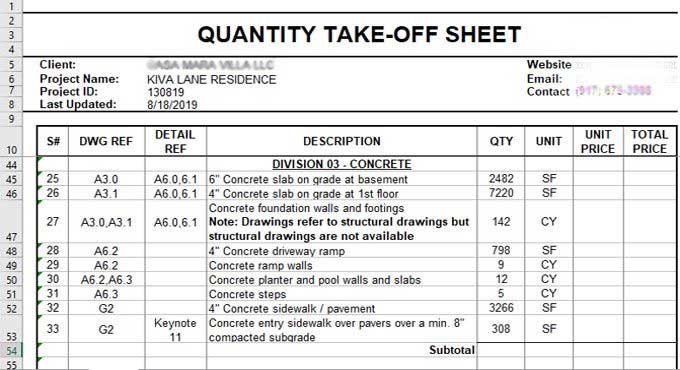
Quantity Take-Off: Applications and What are its Benefits

The construction industry has experienced many changes throughout the years, and through the use of new technologies, it has evolved enormously over the years. This evolution is evident in many ways, but the Quantity Takeoff is an example that is one of the most obvious.
The objective of this article is to explain what a Quantity Takeoff is and to provide you with useful information on what you should know in relation to this topic.
Quantity Takeoffs are based on a thorough analysis of expenses to be taken into account within a project and allow quantity surveyors to develop a complete bill of quantity straight from the measurement data included in a CAD or BIM file.
This phase's importance may be easily understood given that it allows for easier budget control while preventing waste brought on by incorrect estimations.
BIM consists of five dimensions, which are represented by the five dimensions of quantity takeoff, as already mentioned. With this approach, it is possible to extract directly from the BIM model only the metrics that are necessary to define the costs of a building.
Thus, the associated prices can be associated with each item in the BIM model, not only making the process of estimation simpler and more efficient but also making the process of updating the estimated costs easier as well.
A change to something that has been entered into the model, for example, will automatically update the estimate, reducing the number of errors that can arise as a result of manual data entry operations when the model is updated.
Benefits of Quantity Take-Off
The importance of quantity takeoffs is mentioned below:-
Expenditure management
Accurate quantity takeoffs make it simpler to manage construction expenses since you can see exactly how much money you need to spend, which facilitates decision-making and prevents budget overruns.
The right amount of takeoffs will provide you with room for unforeseen costs. All building components' labor, equipment, and supplies may be simply predicted.
Transmission strength
Cost drives everything in the building, and the clients are continuously looking for strategies to maximize their financial resources.
Accurate cost estimates facilitate transparent dialogue that keeps clients informed. This ultimately results in gaining the client's trust, the client will be able to keep tabs on the project's expenses.
Duration surveillance
Quantity takeoffs have an impact on a project's budget and the client's choice of contractor. The process of choosing a contractor is time-consuming, but correct takeoffs can reduce the amount of time spent on rectifications.
Quantity Take-Off Types
Quantity takeoffs can be divided into two types, as discussed below:-
Digital type
Although they are now commonly utilized in the construction sector, digital takeoffs employing computer programs and database applications were relatively new with emerging technology. Due to their efficiency and speed, digital takeoffs are better than manual ones.
Digitizers, which are electronic tools that measure dimensions from drawings and feed the information straight into computer programs, are used in digital takeoffs. No matter what size the photo is placed on, they can scan it.
To implement the cost-based findings in software programs correctly, a highly attentive expert is required since digital takeoffs can be a difficult and complicated operation.
Manual type
The first material takeoff form is this one. Even whether they utilize Microsoft word processors or Excel spreadsheets, building estimators who compute estimates without the help of cost estimation software do so using the manual takeoff approach.
The simplest manual estimates entail going over the requirements and job scope as laid out in the contract drawings and paperwork. The estimator then calculates the precise work measurements required to construct a structure using measurements from those documents.
To match project plans to requirements, the estimator must be able to understand project blueprints. The cost estimator must be meticulous to make sure they don't overlook anything throughout the estimating procedure.
To learn more, watch the following video tutorial.
Video Source: Autodesk
Quantity take-off Procedure
In the preliminary stage, errors can snowball into more costly mistakes in the future. Therefore, we prefer digital quantity takeoffs to manual ones.
Input stage
You must provide accurate data to your takeoff models in order to accomplish good quantity takeoffs. The management of your input is vital whether you are working manually or digitally. Software programs can provide you with excellent planning options.
The cost estimator must have faith in the facts provided because, in the majority of situations, they are not in charge of creating ideas and concepts for a project.
This necessitates a design assessment to verify the veracity of the data being displayed. To verify the accuracy of the models provided, software solutions also contain model checks with conflict detections.
Output stage
It is the output step of the process where the concepts presented in the presented data are converted into the actual specifications that are required for the project. The stage of the project life cycle is where one develops a real estimation of the project's needs along with numbers.
Accurate material estimations are also crucial at this point. The more specific the data, the more effective the submissions will be when putting building bids using it.


